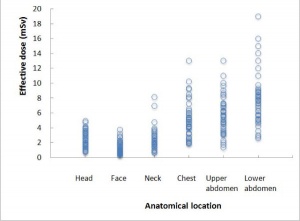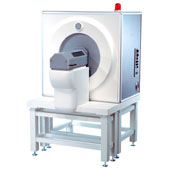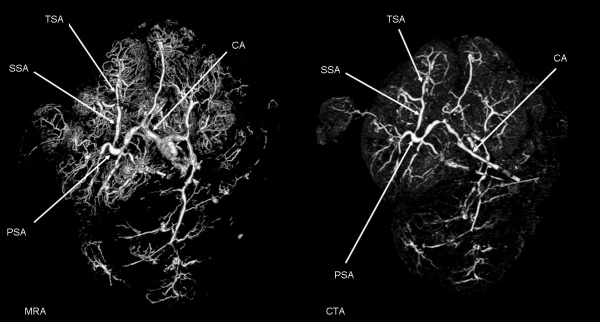Computed Tomography
Introduction
In embryology, the technique of micro-CT (μCT) has recently begun to become relevant in animal models and used for analysis of normal development features and those seen in genetically modified animal models, such as the mouse (More? Mouse Development).
Computed Tomography or computed axial tomography (CAT or CT scan) began in 1970's using x-ray and a computer to produce images either as individual slices or reconstructed to give three dimensional (3D) views of specific anatomical regions or structures.
Other potential developmental research imaging techniques include: positron emission tomography (PET), single photon emission computed tomography, magnetic resonance imaging, computed tomography, optical bioluminescence, fluorescence and high frequency ultrasound.
- Links: Flash - Computed Tomography | Quicktime - Computed Tomography | Abnormal Development - Radiation | Category:Computed Tomography | original page
Some Recent Findings
|
Early Mouse Development MicroCT
Mouse E9.5[3]
Mouse E10.5[3]
Mouse E10.5 head (fixation variations)[1]
Mouse E11.5[3]
Mouse E11.5[3]
Mouse CT E9.5-E12 head[1]
Mouse E12.5[3]
Mouse E14.5[4]
Human Placenta
Right image shows computed tomography angiography (CTA) of the term human placenta viewed from the fetal side.[5]
Legend
- CA - chorionic artery
- PSA - primary stem artery
- SSA - secondary stem artery
- TSA - tertiary stem artery
Movies
| Flash version | |
| Mouse E11.5 microCT scan[6] |
Radiation Exposure

Computed tomography is a source of medical X-ray radiation exposure to the general population. The risk to an individual patient on the basis of dose levels of developing a malignant tumour due to CT is low and acceptable compared to the substantial benefit. There is though a large range/variation in radiation exposure between individual institutions and equipment settings.
Total radiology collective effective dose
- UK (2005-2006) approximately 60% from CT.
- Germany (2000-2005) for cancer patients from all X-ray procedures was approximately 82%.
- USA about 67%
References
- ↑ 1.0 1.1 1.2 <pubmed>20163731</pubmed>| BMC Developmental Biology
- ↑ <pubmed>20190279</pubmed>
- ↑ 3.0 3.1 3.2 3.3 3.4 3.5 <pubmed>16683035</pubmed>| PLoS Genetics
- ↑ <pubmed>18713865</pubmed>| PNAS
- ↑ <pubmed>20226038</pubmed>| BMC Physiol.
- ↑ <pubmed>16683035</pubmed>
- ↑ <pubmed>21044293</pubmed>| BMC Med Imaging.
Search Pubmed
Search Pubmed: Embryo Computed Tomography | Computed Tomography | Micro-computed tomography apparatus
External Links
- University of Calgary 3D Morphometrics Lab
- Duke Center for In Vivo Microscopy A 4D Atlas and Morphologic Database
- Normal C57BL/6 mouse embryos from embryonic day E10.5 to E19.5
- Normal C57BL/6 mouse neonates from post-natal day 0 to 32
- Mutant mouse embryos with cardiac septation defects (conditional ablation of the Smoothened receptor gene, Mef2C-AHF-Cre;Smoflox/- mutants)
Glossary Links
- Glossary: A | B | C | D | E | F | G | H | I | J | K | L | M | N | O | P | Q | R | S | T | U | V | W | X | Y | Z | Numbers | Symbols | Term Link
Cite this page: Hill, M.A. (2024, April 19) Embryology Computed Tomography. Retrieved from https://embryology.med.unsw.edu.au/embryology/index.php/Computed_Tomography
- © Dr Mark Hill 2024, UNSW Embryology ISBN: 978 0 7334 2609 4 - UNSW CRICOS Provider Code No. 00098G

![Mouse E9.5[3]](/embryology/images/thumb/b/b2/Mouse-E9.5.jpg/90px-Mouse-E9.5.jpg)
![Mouse E10.5[3]](/embryology/images/thumb/8/89/Mouse_CT_E10.5.jpg/90px-Mouse_CT_E10.5.jpg)
![Mouse E11.5[3]](/embryology/images/thumb/b/b2/Mouse_CT_E11.5.jpg/90px-Mouse_CT_E11.5.jpg)
![Mouse CT E9.5-E12 head[1]](/embryology/images/thumb/3/39/Mouse_CT_E9.5-E12_head.jpg/120px-Mouse_CT_E9.5-E12_head.jpg)
![Mouse E12.5[3]](/embryology/images/thumb/d/da/Mouse_CT_E12.5.jpg/90px-Mouse_CT_E12.5.jpg)
![Mouse E14.5[4]](/embryology/images/thumb/f/fe/Mouse_CT_E14.5.jpg/77px-Mouse_CT_E14.5.jpg)
